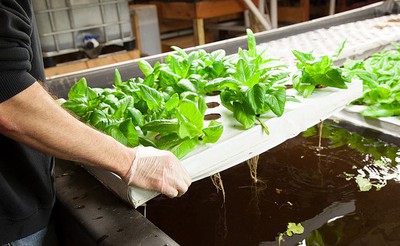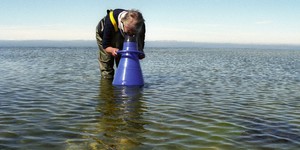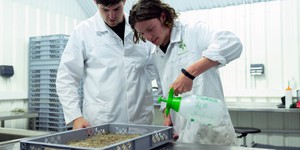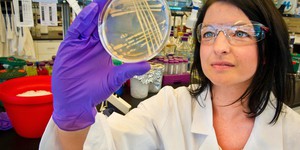Summary

If you want a Project Idea with full instructions, please pick one without an asterisk (*) at the end of the title.
Abstract
How are we going to feed the more than 9 billion people that will live on Earth by 2050? This is a major question for farmers, ranchers, and food scientists around the globe. It's a big problem, considering that from 2017 to 2050 we will be adding 1.5 billion people and need 20% more food. Linked to this problem of producing enough food is having enough land, water, and other natural resources to make that happen. The final solution will surely be made up of many different approaches working together —aquaponics may be one part of the final solution.
Aquaponics combines hydroponics with aquaculture. Hydroponics is the science of growing plants without soil in nutrient-rich water. The nutrients are exactly tailored to nourish and meet the growth requirements of the plants. Plants need nitrogen, phosphorus, potassium, and a variety of other micronutrients to thrive. Normally, in a hydroponics system, synthetic (manufactured) fertilizers added to the water provide these essential nutrients. Aquaculture is the breeding and farming of aquatic organisms, such as fish, shellfish, and aquatic plants, usually for human consumption.
In an aquaponics system, the fish provide nutrients in the form of their "waste," or excrement. This waste contains nitrogen in the form of ammonia (too much of which can be toxic to fish), along with a variety of nutrients like phosphorus and potassium. Nitrifying bacteria that live in the gravel in the fish tank and on the tank walls convert the ammonia first into nitrites and then to nitrates which the plants can use. The water in the tank, which contains ammonia, nitrites, nitrates, phosphorus, potassium, and other micronutrients, is continuously pumped into a grow bed where the plants are located. The plants remove the nutrients from this water, and nitrifying bacteria in the grow bed (working together with the tank filter) clean the water by converting excess ammonia into nitrates, which plants use to grow. The clean water is then sent back into the fish tank. The grow bed and plants act as a biofilter, cleansing the water so that the fish remain healthy. In smaller, backyard aquaponics systems, the grow bed sits on top of the fish tank and the cleansed water from the grow bed drips back into the tank. In aquaponics, the fish, plants, and beneficial bacteria all depend on each other to live. Watch this video to learn more about commercial aquaponics.
What are some advantages of growing food in an aquaponics system? First, it is efficient, producing from one system both food with high protein content (fish) and food with vitamins and minerals (vegetables). Second, aquaponics is mostly a closed system regarding water consumption, because it uses recirculating water. This means it uses minimal water and can be set up in arid areas that don't have plentiful water. All that is required is food for the fish. Finally, aquaponics is a model for sustainable food production because it integrates hydroponics and aquaculture, meaning that it recycles all of the materials it uses.
There are three primary methods for aquaponics: the raft method, the nutrient film technique (or NFT), and the media-filled bed method. The raft method grows plants on boards (rafts) in tanks separate from the fish tank, where the raft supports the plants and the roots of the plants sit directly in the water. Water flows constantly from the fish tank, through filters, through the rafts, and then back to the fish tank. This method is used commercially, as shown in the video, and the extra volume of water in the raft tank is a benefit as it provides a buffer for the fish so they are not stressed by possible water quality problems. With the nutrient film technique, instead of growing the plants in tanks with their roots submerged in the water, the NFT trickles a thin film of water over the roots of the plants, which are grown in narrow channels. This method is not used as heavily as the other two methods because it requires a biofilter to provide additional nitrifying bacteria. In the media-filled bed method, the plants grow in a box filled with a growth medium, such as perlite or gravel, on top of the fish tank. Water from the fish tank is pumped into the box and then percolates through the growth medium and back down into the fish tank. The kinds of plants that can be grown depend on the density of fish in the tank. Lettuce and herbs require low to medium nutrient levels, so they don't need a high density of fish, while fruiting plants like tomatoes have higher nutrient requirements and therefore need a higher density of fish to supply their nutrient needs.
In this environmental engineering science project you will design and build an aquaponics system. As a proof-of-principle you can chose to use fish from your local pet store, like goldfish, rather than trying to find a source of edible fish. Since this project deals with nonhuman vertebrate animals (fish) your science fair may require SRC approval. Review Science Buddies' Scientific Review Committee (SRC) page for additional tips. To get started, you will need to read up on aquaponics and look at systems other people have built. Your project can focus on just the engineering of your home aquaponics system, or you can take it a step further by growing your own produce (lettuce is a good choice) in an aquaponics system compared to a soil-based system. This will allow you to compare many things including how the crop grows in each farming method, cost of each system, amount of water and fertilizer used in each system, or any other variable you can think of! The Science Buddies guide to Measuring Plant Growth can help you design ways to evaluate how well your plants grow.
Bibliography
The following website gives detailed instructions on how to construct a backyard aquaponics system. In addition, there is lots valuable information on aquaponics including a frequently asked questions page.
- Nelson, R. (2012). Build a mini-aquaponics system. Aquaponics Journal. Retrieved March 26, 2012.
- Backyard Aquaponics. (n.d.). Basics. Retrieved March 9, 2017.
- PBS News Hour. (2015). Aquaponic farming saves water, but can it feed the country? . YouTube. Retrieved May 9, 2017.
Ask an Expert
Global Connections
The United Nations Sustainable Development Goals (UNSDGs) are a blueprint to achieve a better and more sustainable future for all.
Careers
If you like this project, you might enjoy exploring these related careers:
Related Links
- Science Fair Project Guide
- Other Ideas Like This
- Environmental Engineering Project Ideas
- Agricultural Technology Project Ideas
- My Favorites














